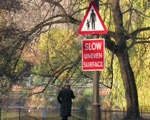 Go to main content
Go to main content
Archive Website of the UK government
Please note that this website has a UK government accesskeys system.
Archive brought to you by Cross Stitch UK
Main menu
Wednesday, 3 October 2023
Page menu
Home and community

How byelaws are made and enforced

Byelaws are made by local authorities, like councils, to tackle local problems. You can usually have your say on suggested byelaws. Find out what byelaws do, and how they’re made and enforced.
What byelaws do
Examples include:
- opening hours for parks and public spaces
- safety rules at arcades and fairs
- stopping people cycling or skating on public paths
- saying where games can be played on beaches
- making sure market stall holders clean up at the end of the day
How byelaws are made
Your council can’t make byelaws without giving local people a chance to see them and have their say. Otherwise the byelaw isn’t valid. The process for making a byelaw is:
- your council consults with local people and responds to concerns
- a draft of the byelaw needs to be approved by government
- your council advertises the byelaw in the local paper
- you can inspect the draft byelaw document at your council’s offices for at least one month
- you can ask for your own copy but you may have to pay a small fee to cover costs
- the Secretary of State approves or rejects the byelaw
- if approved the Secretary of State sets a date for it to become law (usually a month later)
- you can then see a copy of the confirmed byelaw at your council’s offices
How byelaws are enforced
If you break a byelaw you may get a penalty fine (fixed penalty notice). The council will need to take you to the magistrates’ court to make you pay. The fine you get is related to the offence. If this happens to you it does not mean you have a criminal conviction.
 Facebook
Facebook Twitter
Twitter StumbleUpon
StumbleUpon Delicious
Delicious Reddit
Reddit